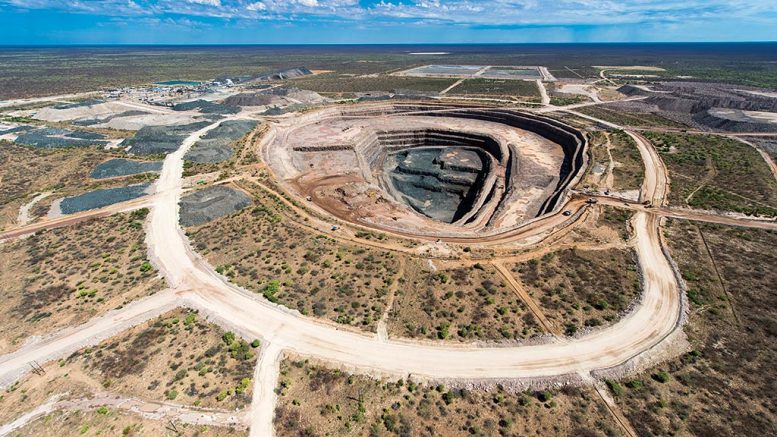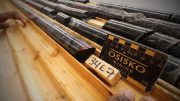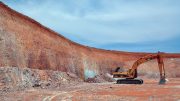The Northern Miner presents the top-ten Canadian-headquartered diamond companies ranked by market capitalization as of late-June.
1. Lucara Diamond
Market capitalization: US$185.6 million

Lucara Diamond president and CEO Eira Thomas speaking at The Northern Miner’s Canadian Mining Symposium held at Canada House in London, U.K., on May 22, 2019. Photo by Martina Lang for The Northern Miner.
Lucara Diamond’s (TSX: LUC) key asset is the wholly owned Karowe mine in Botswana, which has been in production since 2012 and generated 433,060 carats last year. Since Karowe’s 2012 startup, Lucara has become recognized as a consistent producer of large, gem-quality diamonds.
The open pit operation lies in the north-central part of the country and extracts ore from the AK6 Kimberlite, which is part of the Orapa Kimberlite Field (OKF). There are three pipes at AK6, with mineral reserves of 25.4 million tonnes, containing 2.96 million carats in the mine plan. The current open-pit plan extends out to 2026, with the potential to extract additional resources at depth by developing an underground mine at Karowe.
Last year, Lucara released a feasibility study for the underground development, which outlines a 13-year operation, maintaining the current 7,200-tonne per day production rate. With a pre-production capital cost of US$514 million, the after-tax net present value estimate for the project, at an 8% discount rate, came in at US$536 million. Detailed engineering and design work are now underway for this development.
At the end of 2018, Lucara started using the proprietary Clara digital platform to sell diamonds, which works to match rough diamond production to specific polished manufacturing demand to improve margins for both buyers and sellers. Between December 2018 and April 2020, Lucara has completed 23 sales using Clara, with a total value of US$12.3 million.
2. Star Diamond
Market capitalization: US$81.5 million

Rio Tinto bulk sample at Star Diamond’s Star kimberlite in Saskatchewan. Credit: Star Diamond
Star Diamond (TSX: DIAM) holds the Star-Orion South project in Saskatchewan, 60 km east of Prince Albert, which is within the Fort a la Corne diamond district.
The project includes two open-pittable kimberlite deposits. Star features indicated resources of 193 million tonnes at an average diamond grade of 15 carats per hundred tonnes (cpht), containing 28.2 million carats, and 56.9 million inferred tonnes at 11 cpht, for a further 6.4 million carats. Orion South hosts an additional 200.2 million indicated tonnes grading 14 cpht, containing 27.2 million carats and 70.1 million inferred tonnes at 7 cpht, with a further 5.2 million carats.
In 2018, Star Diamond tabled a preliminary economic assessment (PEA) for Star-Orion South. The early-stage study outlines a 38-year operation with a pre-production capital cost of $1.4 billion. The after-tax net present value estimate, at a 7% discount rate, came in at $2 billion.
Star-Orion South received approval from the provincial environment minister in October of 2018.
Rio Tinto’s (NYSE; ASX; LSE: RIO) Canadian subsidiary may earn up to a 60% interest in the company’s Fort a la Corne properties (including Star-Orion South) through spending a total of $70.5 million on exploration and development at Star-Orion South – this includes the completion of a feasibility study. In November 2019, Rio Tinto advised Star Diamond that it would be looking to exercise its full option to earn a 60% share in the Fort a la Corne holdings.
3. Mountain Province Diamonds
Market capitalization: US$45.4 million

Mining at the Gahcho Kue diamond mine. Credit: Mountain Province Diamonds
Mountain Province Diamonds (TSX: MPVD) holds 49% of the Gahcho Kué diamond mine in the Northwest Territories, operated by 51% owner De Beers.
The mine, 300 km northeast of Yellowknife, produced 6.8 million carats in 2019, and has continued to operate during the coronavirus pandemic. The mine plan at Gahcho Kue includes three kimberlites – Hearne, 5034 and Tuzo – and was recently extended two years to 2030.
However, after holding two diamond sales earlier this year, Mountain Province was forced to cancel its third, due to travel restrictions that shut down the diamond trade.
In June, the company closed a $50-million transaction to sell rough diamonds to Dunebridge Worldwide, a company controlled by the company’s largest shareholder, Dermot Desmond. The alternative diamond sale will include only run-of-mine diamonds under 10.8 carats. This deal is expected to provide near-term liquidity while the company waits for a reopening of the global economy and a return to traditional diamond selling methods.
When the diamonds are sold to a third-buyer buyer in the future, Mountain Province will share in 50% of the price upside, minus expenses related to future sales costs and fees.
In addition to Gahcho Kué, Mountain Province holds 671.6 sq. km of adjacent ground as part of the Kennady North project, which includes the Kelvin-Faraday kimberlite corridor.
4. Diamond Fields Resources
Market capitalization: US$8.6 million
Diamond Fields Resources (TSXV: DFR) is an exploration-stage company with interests in mineral projects in Madagascar, Namibia and the Red Sea.
Its diamond assets are in Namibia, where the company holds offshore diamond mining licences. One of these, ML 111, generated a 26,965-carat bulk sample in 2016. The diamonds were then sold in Antwerp at over US$250 per carat. In November 2018, the company started a non-continuous offshore mining program at ML 111, which was completed using a contractor. This campaign was suspended in January 2019, due to a relocation of the mining vessel. Diamond Fields, together with the contractor, is reviewing its operational results to outline opportunities for improved mining performance.
The company also wholly owns ML 139, north of ML 111, and has a 70% interest in ML 32, directly east of ML 111.
In western Madagascar, Diamond Fields holds the Beravina hard-rock zircon deposit, with inferred resources of 1.5 million tonnes grading 22.7% zircon. Last year, the company entered into a cooperation agreement with TMH Acquisition, part of Denham Mining Fund, to advance Beravina in exchange for an initial payment of US$250,000. Under this agreement, TMH may earn up to a 100% interest in the project by making a US$2 million payment to Diamond Fields and granting the company a 9% sales royalty on any future mineral sales.
5. Archon Minerals
Market capitalization: US$7 million
Archon Minerals (TSXV: ACS) holds interests in diamond properties within the Mackenzie mining division in the Northwest Territories.
Archon holds a 2.3% royalty on gross production from the Buffer Zone, which is owned by Dominion Diamond, a private company. The Buffer Zone is adjacent to Dominion’s Ekati diamond mine in the territory and hosts the Jay and Lynx kimberlite pipes. For the year ended May 31, 2019, Archon received royalty payments of $732,393, based on production from the Lynx pipe.
In 2016, Dominion published a feasibility study, which outlined probable diamond reserves in two kimberlite pipes at the Buffer Zone. In addition to these two pipes, Archon’s royalty interest covers at least 11 smaller kimberlite pipes, which are within small drainable lakes and, according to the company, could be fast-tracked to production.
Additional sampling is planned for these areas along with further follow-up of undrilled targets at the Buffer Zone. Archon wholly owns 809 sq. km of mineral leases in the Western Buffer Zone.
The company also holds a 20.4% interest (57.5% Equity Metals [TSXV: EQTY], 22.1% is held by a private party) in the Monument diamond project on the south shore of Lac De Gras. There are 12 known kimberlites at Monument – these are part of the Lac De Gras cluster and lie within 40 km of the Ekati and Diavik diamond mines.
6. Diamcor Mining
Market capitalization: US$4.8 million

The dry-screening plant at Diamcor Mining’s Krone-Endora project in South Africa. Credit: Diamcor Mining
Diamcor Mining (TSXV: DMI) is a diamond explorer focused on projects with near-term production potential.
The company’s most advanced asset is the 70%-owned 59-sq.-km Krone-Endora at Venetia project in South Africa, acquired from De Beers (85% held by Anglo-American [LSE: AAL; JSE: AGL] and 15% owned by the government of Botswana) in 2011, which is adjacent to De Beers’ flagship Venetia diamond mine. Diamonds at Krone-Endora are associated with an upper eluvial and lower alluvial unit, with an interpreted origin at the adjacent Venetia kimberlites, which lie above Krone-Endora.
In 2009, De Beers filed a NI 43-101 compliant resource estimate for the project, which outlines 54.3 million inferred tonnes of diamond-bearing gravels, containing 1.3 million carats of diamonds over an area of 3.1 square kilometres. Diamcor is working to optimize the process flowsheet for the project, as the deposit includes a high sand content, to ultimately make a production decision for this asset.
This test mining and processing program generated revenues for Diamcor in recent quarters from the sale of rough diamonds. In 2011, the company entered into a strategic alliance and $5.5-million financing agreement with Tiffany & Co., with the jewelry company securing a right of first refusal for up to 100% of future production from Krone-Endora at fair value market prices. Diamcor may freely market the larger stones (over 10.8 carats).
7. North Arrow Minerals
Market capitalization: US$5.3 million
With several grassroots diamond discoveries in Canada under its belt, North Arrow Minerals (TSXV: NAR) is now focused on the Q1-4 kimberlite, part of its advanced Naujaat diamond project in Nunavut.
In early June, the junior signed an option agreement with EHR Resources (ASX: EHX) to advance the project with a bulk sample at Q1-4. In return for a $5.6-million investment to collect a 1,500-2,000 tonne bulk sample next year, EHR will earn a 40% interest in Naujaat.
The bulk sample program is slated to start next June. The sample will be shipped and processed during the fourth quarter of 2021, with recovery results expected in the first quarter of 2022. Under the deal, EHR must raise the remainder of the funds for next year’s program by next April.
In addition, the two parties have signed a non-binding letter of intent to negotiate a second agreement under which EHR can earn an additional 20% interest in Naujaat by funding a 10,000-tonne bulk sample.
The 12.5-hectare kimberlite hosts inferred resource of 48.8 million tonnes grading 53.6 carats per hundred tonnes for 26.1 million carats.
North Arrow acquired the 107.4-sq.-km Naujaat project, which hosts a total of eight kimberlite pipes, in 2013 from Stornoway Diamond.
The company also holds the Loki project in the Northwest Territories, as well as a 21% interest in the Lac de Gras joint-venture with Dominion Diamond.
8. Pangolin Diamonds
Market capitalization: US$2.9 million

John Cumming (L) editor-in-chief, The Northern Miner, interviews Leon Daniels, president and CEO, Pangolin Diamonds. Photo by George Matthew Photography.
Pangolin Diamonds (TSXV: PAN) has seven projects totalling 107 sq. km in diamond-rich Botswana.
Pangolin’s most advanced prospect is the AK10 kimberlite, 4.4 km from Lucara Diamond’s Karowe mine. The junior signed an option in mid-2018 with a private company to earn up to 75% of the kimberlite. Under the agreement, the company is required to extract a 500-tonne sample at AK10 before the end of the year.
Before the pandemic, in January, it was awaiting final clearance from the Department of Mines for the program. Like Karowe, AK10 has the potential to host large (50 carats plus), Type IIa diamonds, based on kimberlite indicator mineral analysis.
Pangolin is also advancing earlier-stage exploration projects. It recently announced exploration results from its Kwaneng project, 20 km north of the capital of Gaborone. Drilling at the project intersected a shallow ultramafic hypabyssal dyke with a true width of 6 metres.
The company reports that this dyke material is highly altered and is believed to be geologically similar to diamond-bearing units discovered 33 km away in the late 1990s. Based on soil-sampling results that identified an 850 metre by 250-metre chromite anomaly in the area, Pangolin expects there may be more dykes nearby.
In early June, the company announced it intends to raise $600,000 through a private placement.
In addition, soil sampling at its Malatswae project has returned 19 diamonds to date and an initial drill program testing targets over the 10-sq.-km MSC area at the site recovered one garnet.
9. Metalex Ventures
Market capitalization: US$2.1 million
Metalex Ventures (TSXV: MTX) is focused on diamonds exploration in northern Ontario. The company wholly owns mineral claims in the Kyle Lake region, 80 km west of De Beers’ Victor mine.
In 2005, Metalex discovered the T1 kimberlite pipe within these claims: a follow-up, 408-tonne bulk sample recovered 12,446 commercial-sized diamonds but their size distribution indicated that the pipe was not economic.
In 2006, Metalex completed a geophysical survey over the claims and then tested three priority kimberlites between T1 and the Victor mine. Most of the work to date has been focused on one of these – U2 – which is one of the largest known kimberlites in the region.
A 408-tonne bulk sample collected from U2 in 2010 recovered 1,946 commercial-sized diamonds, with a high proportion of stones in the larger size categories. Based on these results, Metalex plans to extract a 9,072-tonne bulk sample to define the diamond grades and their average values. In 2015, the company received the necessary permits to collect the bulk sample – to do so, it also must secure funding and sign an agreement with the First Nations bands in the area.
Metalex also has a 72% participating interest in the Big Red diamond JV and a 61.7% participating interest in the Dumont JV, both of which are in the Attawapiskat area of Ontario with diamonds exploration targets. The company’s chairman, geologist Charles Fipke, led the team that discovered Dominion Diamond’s Ekati mine.
10. Southstone Minerals
Market capitalization: US$1.2 million
Southstone Minerals (TSXV: SML) has a 43% interest in the 88-sq.-km Oena diamond project in South Africa, a producing alluvial property that is upstream of several producing diamond mines. Oena covers a 15-km long section along the southern bank of the Orange River in the Northern Cape province.
There are two types of diamond-bearing gravels identified at Oena: proto-terraces and meso-terraces.
Proto-terraces are located more than 40 metres above the level of the Orange River while meso-terraces are 10 metres to 12 metres above the river. Southstone has identified five meso-terraces at Oena: the Oena, Sandberg, Blokwerf, Fishriver and Kabies sections.
Exploration and mining work has been ongoing at Oena since 1992. The Oena section proto-terrace was mined until 1995 and produced 30,000 carats, with an average stone size of 2 carats. The largest diamond recovered during this period weighed 79 carats. After a 5-year test mining period, between 2000 and 2006, additional drilling at the site targeted the meso-terraces, which was followed by a bulk sampling program and a year and a half of trial mining.
Current inferred resources at Oena stand at 2.8 million tonnes grading 0.12 carats per hundred tonnes.
In 2017, a mining contractor started up mining and processing equipment at Oena. The mine receives between 25% and 40% of the gross income from the sales, after commissions. Since 2014, Oena has produced 2,327 carats of diamonds, sold at an average price of US$1,298 per carat.






Be the first to comment on "Top 10 Canadian-headquartered diamond companies"